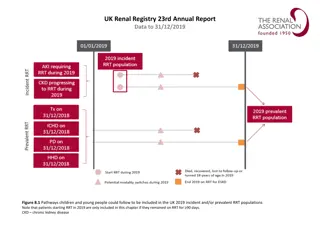
Understanding Crystallographic Planes in Materials Science
Explore the concept of crystallographic planes in materials science, characterized by Miller indices and interplanar distances. Learn about atomic packing on specific planes and how to calculate planar density. Visualize crystallographic planes with examples and understand the significance of Miller indices in identifying crystallographic planes.
Download Presentation

Please find below an Image/Link to download the presentation.
The content on the website is provided AS IS for your information and personal use only. It may not be sold, licensed, or shared on other websites without obtaining consent from the author. If you encounter any issues during the download, it is possible that the publisher has removed the file from their server.
You are allowed to download the files provided on this website for personal or commercial use, subject to the condition that they are used lawfully. All files are the property of their respective owners.
The content on the website is provided AS IS for your information and personal use only. It may not be sold, licensed, or shared on other websites without obtaining consent from the author.
E N D
Presentation Transcript
MILLER PLANES Atoms form periodically arranged planes Any set of planes is characterized by: (1) their orientation in the crystal (hkl) Miller indices (2) their d-spacing (dhkl) distance between the planes h, k, l correspond to the number of segments in which the a, b, c axes, respectively, are cut by the set of planes On average, the higher (hkl), the closer is the interplanar distance, dhkl 2-D Examples 3
Crystallographic Planes We want to examine the atomic packing of crystallographic planes Iron foil can be used as a catalyst. The atomic packing of the exposed planes is important. a) Draw (100) and (111) crystallographic planes for Fe. b) Calculate the planar density for each of these planes.
MILLER PLANES c b a 5
MILLER PLANES c b a 6
MILLER PLANES c b a 7
MILLER PLANES c b a 8
MILLER PLANES c b a 9
MILLER PLANES c b a 10
MILLER PLANES c b a 11
- Crystal planes Considering 2D lattice -1a y 1b b x 1b a 2b 1b 1a 3a There are many ways connecting lattice points
Crystallographic Planes Miller Indices: Reciprocals of the (three) axial intercepts for a plane, cleared of fractions & common multiples. All parallel planes have same Miller indices. Algorithm 1. Read off intercepts of plane with axes in terms of a, b, c 2. Take reciprocals of intercepts 3. Reduce to smallest integer values 4. Enclose in parentheses, no commas i.e., (hkl)
Connecting points 1a and 1b denoted as (1a, 1b) or (1, 1) 3a and 2b -1a and 1b a and 1b (3a, 2b) or (3, 2) (-1a, 1b) or (-1, 1) (+ a, 2b) or (+ , 2) (1,1) (3,2) (-1,1) (+ , 2)
d. d-spacing dhkl (010) d010 (110) d110 ( 2 10) (210) ( 1 20)
Extending to 3D lattice lines connecting points extend to z-direction (c) forming plane 1a-1b designate (1a, 1b, c) or (1, 1, ) 3a-2b designate (3a, 2b, c) or (3, 2, ) -1a-1b designate (-1a, 1b, c) or (-1, 1, ) + a-1b designate (+ a, 1b, c) or ( , 1, ) It is not convenient to represent plane coordinates as , a reciprocal representation called Miller indices, (h k l) is rather used. (1, 1, ) (1/1, 1/1, 1/ ) (1 1 0) (3, 2, ) (1/3, 1/2, 1/ ) (2 3 0) (-1, 1, ) (-1/1, 1/1, 1/ ) (1 1 0) ( , 1, ) (1/ , 1/1, 1/ ) (0 1 0)
Crystallographic Planes z example abc c 1 1 1/1 1/1 1/ 1 1 0 1 1 0 1. Intercepts 2. Reciprocals y 3. Reduction b a 4. Miller Indices (110) x z example 1. Intercepts 2. Reciprocals abc 1/2 1/ 1/ 1/ 2 0 0 2 0 0 c 3. Reduction y b a 4. Miller Indices (100) x
Crystallographic Planes z example 1. Intercepts 2. Reciprocals a b c c 1/2 1 3/4 1/ 1/1 1/ 2 1 4/3 y b a 3. Reduction 6 3 4 x 4. Miller Indices (634) Family of Planes {hkl} Ex: {100} = (100), (010), (001), (100), (010), (001)
Crystallographic Planes Adapted from Fig. 3.9, Callister 7e.
HCP Crystallographic Directions z Algorithm 1. Vector repositioned (if necessary) to pass through origin. 2. Read off projections in terms of unit cell dimensions a1, a2, a3, or c 3. Adjust to smallest integer values 4. Enclose in square brackets, no commas [uvtw] a2 - a3 a2 a1 -a3 a2 Adapted from Fig. 3.8(a), Callister 7e. 2 a3 [1120] ex: , , -1, 0 => a1 2 dashed red lines indicate projections onto a1 and a2 axes a1
HCP Crystallographic Directions Hexagonal Crystals 4 parameter Miller-Bravais lattice coordinates are related to the direction indices (i.e., u'v'w') as follows. z [ u v ' ' w ] ' [ uvtw ] 1 = - u ( 2 u ' v ) ' 3 a2 1 = - v ( 2 v ' u ) ' 3 - = a3 - + t ( u v ) a1 = w w ' Fig. 3.8(a), Callister 7e.
Crystallographic Planes (HCP) In hexagonal unit cells the same idea is used z example 1. Intercepts 2. Reciprocals a1a2a3 1 1 1/ 1 0 1 0 c 1 1 1 1 -1 -1 -1 -1 a2 3. Reduction a3 4. Miller-Bravais Indices (1011) a1 Adapted from Fig. 3.8(a), Callister 7e.
The distance between each plane can be calculated For 2 (h k 0) planes d = sin ( ) a h d b h d d = cos ( ( ) ) / b k + = 2 2 sin cos 1 2 2 2 d d / + = 1 ( ) ( ( ) ) 2 2 2 b h b k a h 2 2 h a k b + = 2 1 d 2 2 2 2 1 h a k b = + 2 2 2 d
Similarly for 2 (h k l) planes 2 2 2 1 d h a k b l c = + + 2 2 2 2 If a, b, c and h, k, l are known , d can be computed
Example 7.1 Calculate the separation of (a) the (123) planes and (b) the (246) planes of an orthorhombic cell with a = 0.82 nm, b = 0.94 nm, and c = 0.75 nm 2 2 2 1 h a k b l c From = + + 2 2 2 2 d 1 1 4 9 (a) = + + ( ) ( ) ( ) 2 2 2 2 d 0.82 0.94 0.75 2 ( ) = 22 nm 1 22 = = 2 0.21 d nm
1 4 16 0.94 36 0.75 (b) = + + ( ) ( ) ( ) 2 2 2 2 d 0.82 2 ( ) = 4 22 x nm 1 x = = 2 0.10 d nm 4 22
Miller Indices 2 Miller Indices of Directions 1. Choose a point on the direction as the origin. z 2. Choose a coordinate system with axes parallel to the unit cell edges. y 3. Find the coordinates of another point on the direction in terms of a, b and c 1a+0b+0c 1, 0, 0 x 4. Reduce the coordinates to smallest integers. 1, 0, 0 5. Put in square brackets [100]
Miller Indices 3 z Miller indices of a direction represents only the orientation of the line corresponding to the direction and not its position or sense y [100] x All parallel directions have the same Miller indices
Miller Indices of Directions (contd.) z OA=1/2 a + 1/2 b + 1 c Q z 1/2, 1/2, 1 A [1 1 2] y PQ = -1 a -1 b + 1 c y O -1, -1, 1 _ _ P x [ 1 1 1 ] x -ve steps are shown as bar over the number
Miller Indices 4 Miller indices of a family of symmetry related directions uvw = [uvw] and all other directions related to [uvw] by the symmetry of the crystal [001] Tetragonal Cubic [010] [010] [100] [100] = [100], [010] 100 = [100], [010], [001] 100 tetragonal cubic
Miller Indices for planes z 1. Select a crystallographic coordinate system with origin not on the plane 2. Find intercepts along axes in terms of respective lattice parameters 1 1 1 y 3. Take reciprocal 1 1 1 O 4. Convert to smallest integers in the same ratio x 1 1 1 5. Enclose in parenthesis (111)
Miller Indices for planes (contd.) Plane ABCD OCBE origin O O* z z 1 1 -1 intercepts E reciprocals 1 0 0 1 -1 0 _ Miller Indices A B (1 0 0) (1 1 0) O* O y Zero represents that the plane is parallel to the corresponding axis Bar represents a negative intercept D C x x
Miller indices of a plane specifies only its orientation in space not its position All parallel planes have the same Miller Indices z E _ _ _ (h k l ) (h k l ) A B O _ (100) (100) y D C x (100)
Miller indices of a family of symmetry related planes = (hkl) and all other planes related to (hkl) by the symmetry of the crystal {hkl } All the faces of the cube are equivalent to each other by symmetry Front & back faces: (100) Left and right faces: (010) Top and bottom faces: (001) {100}= (100), (010), (001)
Miller indices of a family of symmetry related planes z Tetragonal z Cubic y y x x {100}tetragonal = (100), (010) {100}cubic = (100), (010), (001) (001)
Some IMPORTANT Results Weiss zone law Not in the textbook Condition for a direction [uvw] to be parallel to a plane or lie in the plane (hkl): h u + k v + l w = 0 True for ALL crystal systems
CUBIC CRYSTALS [111] [hkl] (hkl) C (111) Angle between two directions [h1k1l1] and [h2k2l2]: + + h h k k l l + = 1 k 2 1 2 h 1 2 k cos 2 1 2 1 2 1 l 2 2 2 2 2 2 + + + h l
dhkl Interplanar spacing between successive (hkl) planes passing through the corners of the unit cell cubic hkl = a d 2 2 2 + + h k l z E B O O = a d a = 100 d 1 1 0 2 (100) x x
Summary of Notation convention for Indices [uvw] parallel directions) Miller indices of a direction (i.e. a set of (hkl) parallel planes) Miller Indices of a plane (i.e. a set of <uvw> related directions Miller indices of a family of symmetry {hkl} related planes Miller indices of a family of symmetry
7.1.4 Crystal Planes and Miller Indices a.Lattice planes It is possible to describe certain directions and planes with respect to the crystal lattice using a set of three integers referred to as Miller Indices. Miller indices describe the orientation and spacing of a family of planes. (010) Simple Tetragonal Lattices: projections of crystals planes (parallel to the c- axis) on the (001) plane. (110) ( 2 10) (210) ( 1 20)
b.Miller indices (hkl) Miller indices are the reciprocal intercepts of the plane on the unit cell axes. 1 1 1 = : : : : h k l r s t Example: 1/3:1/2:1/1 = 2:3:6 The Miller index is (236)
Examples of Miller indices 1 ( ) 0 1 (110) c b (111) a c (100) (010) b c a b origin a
(hkil), i=-(h+k) hexagonal, four axis (a1,a2,a3,c) (0001) c c c a3 a3 90 90 90 90 1 ( 2 ) 0 1 a2 a2 1 ( 1 00 ) 120 120 120 120 b a1 a1 a 10 ( ) 1 1 hexagonal, four axis (a1,a2,-(a1+a2),c)
C. Directions in lattice [122] [122] [001] [001] c c [100] [100] [110] [110] b b [210] [210] [100] [100] a a 1 [ 1 [ ] 0 2 ] 0 2 1 [ 1 [ ] 0 2 ] 0 2
Example: Directions on the (111) plane. 1 [ 1 [ ] 2 1 ] 2 1 1 [ 1 [ 10 10 ] ] c c 0 [ 0 [ ] 1 1 ] 1 1 b b a a (111) (111)
Miller indices (hkl) are used to specify the orientation and spacing of a family of planes. {hkl} are used to specify all symmetry- equivalent sets of planes Miller indices [hkl] are used to specify a direction in space with respect of the unit cell axes. <hkl> are used to specify a set of symmetry- equivalent directions. [uvw] zone axis Direction Vector = ua + vb + wc
The spacing between adjacent planes in a family is referred to as a d-spacing Cubic : 1/d2 = (h2+k2+l2)/a2 or d2 = a2/(h2+k2+l2) Tetragonal: 1/d2 = (h2+k2)/a2 + l2/c2 Orthorhombic: 1/d2 = h2/a2+k2/b2 + l2/c2 Hexagonal: 1/d2 = (4/3)(h2+hk+k2)/a2 + l2/c2 Monoclinic: 1/d2 = [(h/a)2 + (k/b)2sin2 + (l/c)2- (2hl/ac)cos ]/sin2 Triclinic:






















